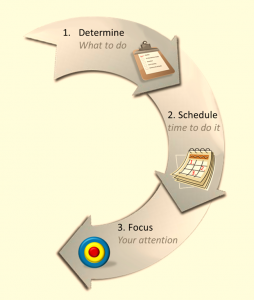Continuing with our series on the Productivity Workflow Formula™ (PWF)
Step 3: Focus Your Attention: REDUCE YOUR DISTRACTIONS
So as you embark on your voyage of self-improvement, don’t get in a hurry. Accept that developing a new routine takes time. Leo Babauta, the author of the influential Zen Habits blog, recommends setting yourself a 30-day challenge for changing each habit.
In this step, you reduce distractions so you can hone your focus to razor sharpness. Once you know exactly what you should be doing and have captured time to do it, you must focus on completing that important task. Distractions represent some of the worst productivity hurdles; even if they drag your attention away for just a few seconds at a time, they can cause you to lose your train of thought and fall out of the productive focus in which you accomplish your best work.
Take steps to ease external distractions like people chatting in the hallway, interruptions from co-workers, or traffic past your office or cubicle. If nothing else, you can close your door (assuming you have one), or take your laptop into an empty conference room, or establish signals to let your co-workers know when you’d prefer they not disturb you. To keep your electronics from repeatedly shattering your focus, turn off email alarms and instant messaging and let your calls roll over to voicemail.
Internal distractions often prove more dangerous than external ones, because they represent hurdles we put up ourselves. We don’t intend to waste time but inevitably do it with gossiping, socializing, procrastinating, and constantly checking email. Ironically, some of the worst internal distractions come from efforts to “increase” personal productivity. Perfectionism, for example, often backfires, because trying to predict everything that could possibly go wrong means you never get started—and when you do get to work, you have a hard time letting go.
But few internal distractions hurt productivity as much as multitasking. Trying to do too much at once divides your attention, and one task actually gets in the way of the next. You lose track because you switch between tasks too often. Single-tasking works better: instead of juggling several tasks, focus on one until you’ve reached a natural stopping point (or you’ve completed it), and then move on to the next.
Step 4: Coming Soon!
You can get the full details on all six steps in What To Do When There’s Too Much To Do, my brand new handbook for maximizing workplace productivity without running yourself into the ground. Buy your copy at Amazon, Barnes and Noble, or 800CEORead and email your receipt to [email protected] for special bonuses by author friends of Laura Stack. Visit www.TheProductivityPro.com/WhatToDo for complete details.



